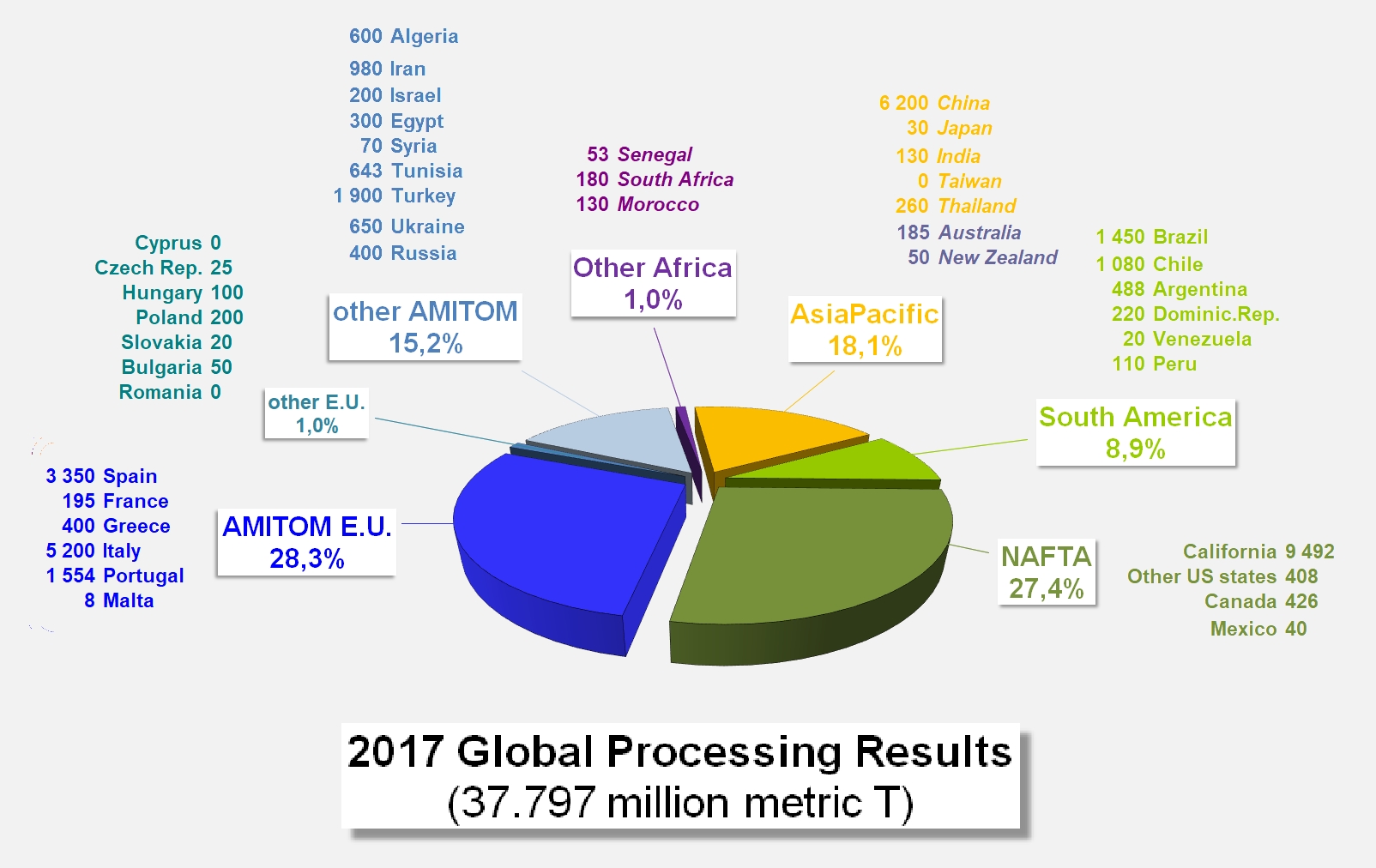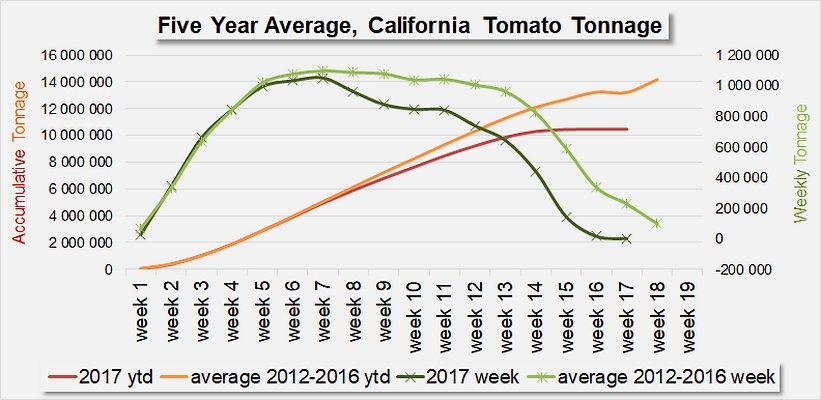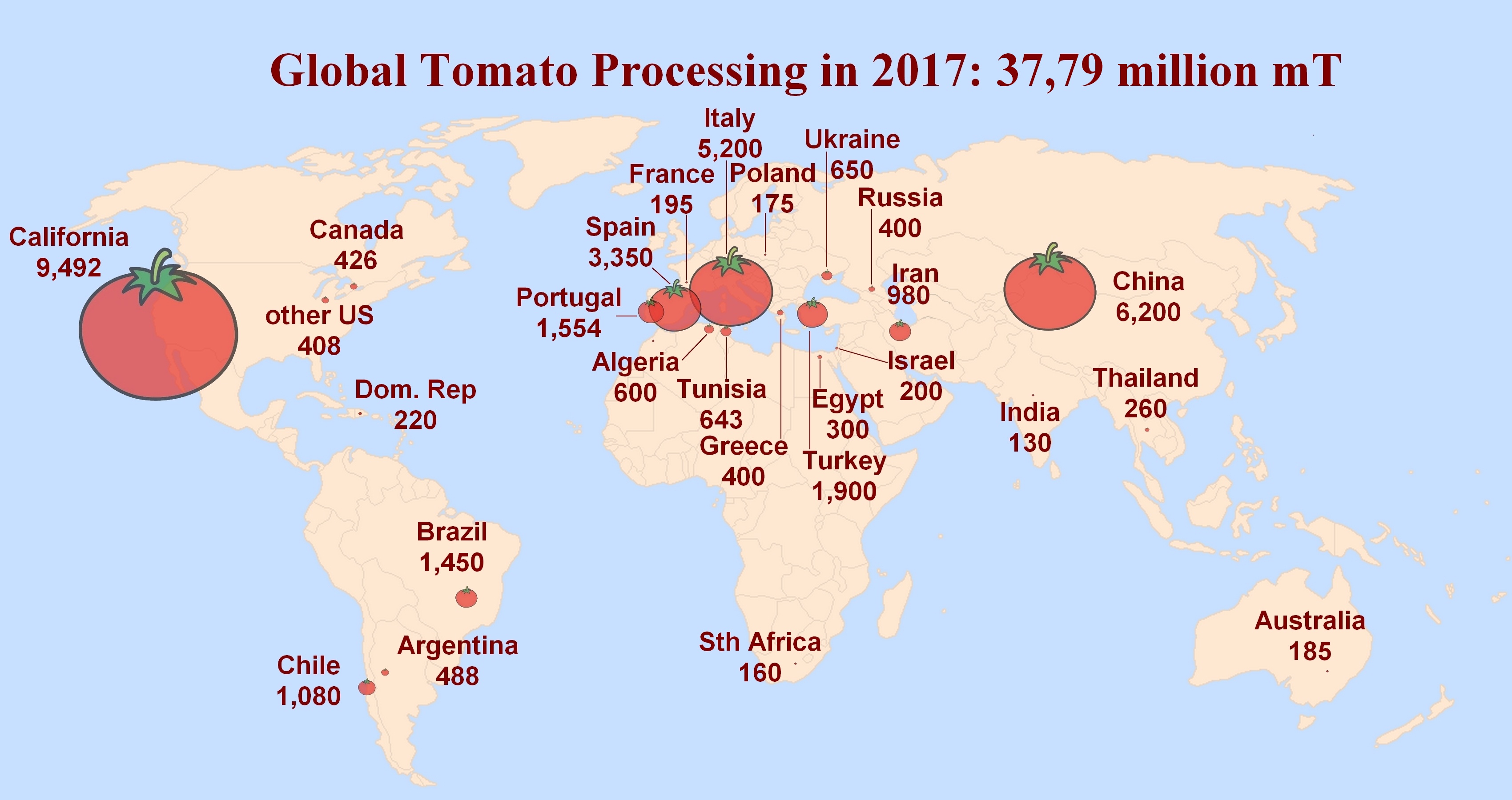Sophie Colvine
, François-Xavier Branthôme
-
The final production figures released by WPTC in February 2018 estimate that a total 37.8 million metric tonnes (mT) of tomatoes were processed globally in 2017, only marginally less than the 38.07 million mT processed in 2016, but 700,000 mT less than was expected before the start of the season in June 2017. Drought in a number of countries like Italy, heavy rainfall during planting operations in others (like Greece, Turkey, California and Canada) and in many cases the effects of a string of major heatwaves throughout the summer all had an impact on the harvest and led to a drop in processed volumes compared to initial plans.

AMITOM Countries
The global forecast for the AMITOM countries turned out to be very reliable in 2017, with the final production (16.45 million mT) varying by only 70,000 mT (0.4%) from initial intentions (16.52 million mT. In 2017, the volumes processed by AMITOM countries accounted for 43.5% of total worldwide quantities.
In Italy, the very good weather in September lead to an increase in the total volume to the final volume of 5.2 million mT.
In the North, major heatwaves in June and in July caused issues with irrigation and affected both agricultural and industrial yields. Good weather in September, however, enabled to increase the total volume processed to 2.73 million mT, higher than the initial estimate of 2.55 million mT.
In the South, the total production was 2.47 million mT. Quality was quite good and farm yields were excellent at above 90 t/ha on average and with the absence of diseases due to a very dry summer. The downside was the higher cost of irrigation.
In Spain and in Portugal, the 2017 crop was difficult but in the end production was higher than expected also due to a good September, to respectively 3.3 million mT and 1.55 million mT. In Portugal, low farm yields and whiteflies plagued the middle of the crop but September saved a very difficult season where average brix was between 5 and 5.2.
In Greece, the final production was 400,000 mT, a large reduction from the 480,000 mT initial target due to a succession of rains and heatwaves early in the season.
In France production was on target at 195,000 mT.
In non-EU AMITOM countries, 2017 crop was generally good with production reaching the objectives: in Turkey, the crop finished with the total volume processed being estimated at 1.9 million mT.
In Tunisia, 643,000 mT were processed from a total volume of 900,000 mT of tomatoes harvested from the 14,275 hectares planted.
In Ukraine, the final production was 650,000 mT as forecast. This was a good season with no interruption due to rain, good yields of about 90 t/ha.
While in neighbouring Russia, the 2017 season was good with a final production of 400,000 mT as two plants opened at the end of 2016 season started to operate at full capacity.
North America
In California, the season was very difficult and saw several successive adjustments in processing prospects. Planting operations were disrupted by heavy rains, which did however greatly improve the situation with regard to the drought. Processing estimations (11.6 million short tons (sT) or 10.52 million mT) were downscaled and the final result was only 10.463 million sT (9.492 million mT).

A further 408,000 mT processed were added to these figures by operators in other US states: in the final count, US results for 2017 stand at 9.9 million mT, down by close on 2 million mT on the 2016 results (11.47 million mT). This decrease in the level of operations, which was partly planned by Californian operators but exacerbated by the difficult season, contributed to the recovery of the situation in terms of inventories.
In Canada, final production was 426,000 mT, slightly above contract tonnage. The season was generally good with good quality fruits.
Other countries
In China, weather conditions have not had much effect on the size of the harvest. The crops might have been affected by the heatwave but in the end, the level of operations suffered more from the effects of interruptions imposed for sanitary reasons on several of the factories in the region. The size of the crop was estimated at 5.94 million mT in October 2017, but was later increased to 6.2 million mT. Production in China accounted for slightly more than 16% of global volumes.
Other major processing regions were responsible for about 14% of global operations. Of these 4.2 million mT, countries of South America (Brazil, Chile, Argentina, Peru, etc.) processed 3.37 million mT in 2017, which was approximately 9% of the world's production in 2017.
The final production in Argentina was 488,000 mT with a record yield of 79 t/ha. The final number was the second historic harvest (2014 was 535,000 mT). In Chile, production reached 1.08 million mT. The factories worked until the end of April, with in general good weather conditions. The average yield was around 93 t/ha. In neighboring Peru, the harvest ended with a total crop of 110,000 mT.
Later in the year, the Brazilian tomato season was really good, with a total volume of 1.45 million mT, most because climate conditions with low maximum temperatures and very dry weather.
In Australia, the season came to an abrupt end on 17 May 2017 following rain events. The final tonnage was 184,695 mT when the initial forecast was over 250,000 mT.
While in South Africa, at total of 160,000 tonnes were processed, first in the Western Cape region, then in the Limpopo province.

You can find a more detailed version of this article in the TOMATO NEWS “2018 Processed Tomato Yearbook”. This 100-pages publication gives a comprehensive picture of the global tomato processing industry in 2018 with detailed production figures, a description of the industry in each of the main processing countries, a detailed analysis of trade statistics, the latest WPTC consumption study, prices of tomato paste, a summary of all articles published online in the last year and the complete industry directory.
Copies of the YEARBOOK, which was distributed to all attendees at the 13th World Processing Tomato Congress, can be purchased at a cost of 75 euros (+VAT if applicable but including global postage) from
http://www.tomatonews.com/en/get-listed_5.html
































